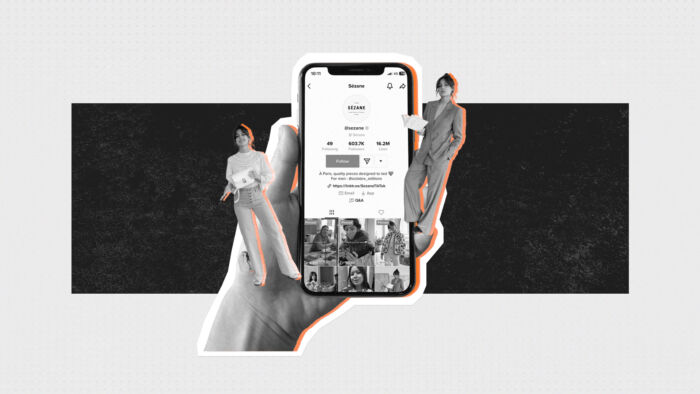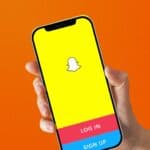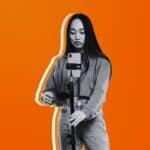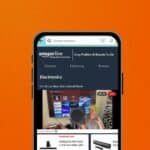When it comes to an influencer marketing campaign, nothing is more important than partnering with the right creators. This is easier said than done though, and sometimes people’s idea of what the “right creator” is can differ.
Some marketers put follower size above everything else, but there are so many more things to consider.
Having delivered hundreds of influencer marketing campaigns over the past nine years of Goat, we’re bringing you our recommendations for building effective influencer partnerships, as well as examples of brands that have got it right.
Contents
Common mistakes brands make when choosing influencers to partner with
How brands can partner with the right influencers
Examples of Brand/Influencer Partnerships that made total sense (and why they worked)

Common mistakes brands make when choosing influencers to partner with
Thinking that bigger always = better
One of the biggest debates in the influencer space surrounds influencer sizing, and the effectiveness of macro vs micro, we even put this to a debate. We learned that while there are some pretty lucrative arguments for both sides, brand’s goals will ultimately determine your influencer selection and you shouldn’t just be enticed by a big following.
Going in with the mindset that bigger equals better is outdated. If that was the case, brands would always look to partner with social media’s most followed personalities – the Kim Kardashian’s and the Cristiano Ronaldo’s. While influencers in this bracket have astronomical followings, that doesn’t always mean that these followers are actively engaged. Of course this is campaign dependent, an awareness campaign is bound to reach a large pool of followers with these larger influencers. But, in some cases, opting for a smaller creator with higher levels of engagement may prove more beneficial depending on your campaign objectives.
In essence, there is a lot to consider, and looking at influencers exclusively for their size or following is a surefire way to get left behind.
Believing all influencers have “influence”
The biggest and most common mistake is believing that every influencer has “influence” over their audience. It’s often the case that an influencer’s following and engagement level does not guarantee ROI.
The best influencers are actively engaged and involved with their community, and have spent time cultivating or following as opposed to chasing notoriety. For influencer marketing to work, an influencer’s audience must be connected with them on a deeper level than simply following them online, there has to be a level of trust developed over time.
Not vetting influencers sufficiently
While more influencers are starting to graduate to celebrity status, the draw of influencers is still their relatability because, after all, they’re people that audiences can connect with. And because they’re people, they have values that they stand by.
While checking if an influencer’s following isn’t built upon a series of bots is important, it’s even more vital to understand the influencer you want to partner with. Who is their audience, and how do they connect with them? Do their values and audience’s values align with your brand’s? Influencer marketing campaigns should look to foster partnerships where brand and creator ethos align to maintain authenticity.
Staying in one lane
For every niche community out there, from welders and roller skaters to bookworms and financiers, there’s a content creator cultivating that community with engaging content. With so many influencers to choose from, how is it then that brands get things wrong?
One of the greatest benefits from influencer marketing is the fact it gives brands a way to reach new audiences. Of course it makes sense for beauty brands to partner with beauty creators, but it’s about being open to tapping into other niches and trying things that are outside of the box. If you always do the same thing, you’ll always be targeting the same audience, and ultimately you’ll start to stagnate.
We’ve seen this in the past with beauty brands like NYX Cosmetics partnering with gaming influencers on Twitch in a bid to reach gaming audiences, or how luxury fashion brands like Hugo Boss utilize TikTokers such as Khaby Lame to reach younger demographics. By diversifying their approach, these brands can expand their reach beyond their existing customers and create unique content that appeals to a multitude of audiences.
How brands can partner with the right influencers
Determine exactly who it is you’re trying to reach
If you want your influencer marketing campaign to be precise and effective, you’re going to have to determine exactly who it is you’re targeting. Underline the demographics, preferences and behaviors. Find out where they’re spending their time on social, and how they’re consuming content. Find out what they want from brands, any pain points they might have, and how you can offer a solution.
By identifying your target audience, you can find influencers who appeal to them, who share similar traits and values, along with the ability to engage. A well-defined target audience also aids in crafting tailored content, increasing the likelihood of successful conversion and brand loyalty. Without this strategic alignment, brands risk misconnecting with audiences, diluting their message, and missing opportunities to establish meaningful connections that drive tangible results in this highly competitive landscape
Leverage influencer marketing tools
One of the easiest ways to connect with influencers is to leverage influencer marketing tools. These tools will enable you to filter, analyze, and get in touch with potential partners. Influencer marketing tools are built upon data and analytics that help filter influencers by their followings, engagement rates and other metrics.
There are plenty of tools on the market that house data around influencers, influencer marketing campaigns, metrics, and results. These tools and platforms allow brands to refine their influencer search and find creators that align with their goals, but they aren’t without inefficiencies. Tools like Woomio enable brands to search for influencers by size, vertical and platform, and navigate influencer campaigns within the previous year. There are also tools like Upfluence that lets brands look at pieces of content for their reach and engagement metrics, but the software doesn’t support bulk analysis and requires a manual influencer search.
Fortunately, we built our own data-led solution, Ibex. With this tool, we can store the data of every influencer, every campaign, every cost per, and every result captured over the last nine years. Ibex helps brands overcome the challenges of influencer marketing, giving them a competitive edge with accurate metrics and data-led learnings.
Work with an influencer marketing agency
Want an all-in-one solution? Partner with an influencer marketing agency. Influencer agencies provide greater expertise, access to a larger pool of influencers, quality control, efficiency, and performance tracking and reporting.
Influencer agencies have experience and expertise in identifying and working with influencers, and they can save brands time and resources by handling administrative tasks such as contract negotiation, content approval, and payment processing. They also have relationships with influencers and can negotiate more effectively on behalf of the brand. With an Influencer marketing agency, brands are provided quality control by vetting influencers, ensuring that they meet brand’s standards and expectations. Partnering with an agency also means that they can track the performance of campaigns and provide detailed reports to assess the effectiveness of the campaign.
Some of the best influencer campaigns are often a result of partnership with an Influencer marketing agency. Check out some of our best work over on our website.
Examples of Brand/Influencer Partnerships that made total sense (and why they worked)
Once you’ve successfully partnered with the right influencers, it’s important to establish the ground rules, without siphoning the creativity out of creator content.
It’s vital that brands strike the balance between providing a guiding hand and giving creators some breathing room to come up with something that their audience will resonate with.
Partnering with the right influencers, and giving them the freedom to do what they do best, should look something like this:
Kraken Rum
Kraken Rum is famous for its dark spiced rum. Over the years the brand has built a persona that is mischievous and mysterious, with a dash of playfulness.
Last year they enlisted us to help them build awareness and consideration through a creative influencer-first social campaign; the launch of its new Gold Spiced Rum.
We kicked off with an in-person event held in New York City, where we invited local influencers to create content and build the hype for the pending product reveal. Then came the launch of ‘Hour of the Kraken’, a series of creative videos focusing on highly aesthetic Reels and YouTube Shorts content to create a more memorable release for the new beverage.
Our goal was to partner with creators that spoke the Kraken language. Some of our “Kraken Mavericks’ included TooTurntTony and Logan Lisle among others. With a handle containing “TooTurnt” Anthony Dawson was a perfect match for Kraken Rum from the get-go. He’s known for his comedic skits, wildlife conservation advocacy, and content featuring his pet goat, and ducks – the perfect fit for Kraken’s more light-hearted campaign. Logan was a natural fit for Kraken too. His audience are accustomed to his comedic content (90% dad jokes) which the Kraken audience loved. One commenter added “I appreciate a good ad that doesn’t feel fake or forced and is yet still true to the content.”
Liquid Death
Don’t let the name put you off, it’s just water. Liquid Death is a US beverage brand causing a stir in the H2O market. The brand is known for its outside-the-box marketing strategies that tap into the nihilism of Generation Z. They’re known to do things that are a bit wild, but it’s all for a good cause – the brand dedicates 10% of its profits to the fight against plastic, which is something continuously reflected through its content.
Since the brand does some pretty crazy things, it would only make sense to enlist influencer partners that carry that same weight and persona. In August last year, they partnered with the former Jackass stuntman, Steve O, where they released the Steve O Voodoo Doll, an all natural product that fans could buy to stick pins in, set on fire, or tickle. A month prior, they partnered with another Jackass star, Zach Holmes, for a video that saw taste testers licking sweat off his back. This was the brand’s spin on a comment that read “I’d rather lick sweat off a fat guy’s back than drink Liquid Death.”
Gen Z loves Liquid Death’s irreverence and it’s dark undertones because they get the joke. It’s nihilism and satirical comedy rolled into one, and the brand’s partnerships with influencers like Steve O and Holmes showcase everything that the brand is all about.
Arla
We’ve done some fantastic work with Arla over the past year across many of its brands including Cravendale.
October last year marked Cravendale’s 25th anniversary. We worked with Arla to host a party championed by the charismatic young farmer Kaleb Cooper and the culinary wizard, and rapper, Big Zuu! In celebration of its birthday, Cravendale both personalities to weave through a day of merriment, and learn more about the brand’s exceptional milk. The campaign brought the bes out of both creators, Cooper flexing his agriculture knowledge, and Big Zuu rapping about milk.
For anyone who hasn’t seen Clarkson’s Farm, Kaleb Cooper is a farming contractor who plays a central advisory role to Jeremy Clarkson in the Prime Video series. Adorned in a Schöffel, checked shirt, and durable Wellington boots, Cooper represents the worlds of agriculture and husbandry. There simply isn’t a better fit for the Cravendale brand. On the other hand, Big Zuu has emerged as a culinary powerhouse, with an infectious personality, and cultural ties to music, TV, and Liverpool FC. The duo’s camaraderie perfectly encapsulated Cravendale’s momentous celebration of 25 years in business.
Concluding thoughts
Getting your influencer partnerships right is a necessity if you want to achieve measurable success, foster a stronger connection with your target audience, and if you want to create a more memorable experience.
Brands should look to enlist influencers that encapsulate what they’re all about. If a creator’s values and interests aren’t in alignment with your brand then it’s likely that you’re looking in the wrong place.
Fortunately for brands, there are plenty of solutions for nailing influencer partnerships every time. Consider leveraging influencer marketing tools, and consider joining forces with an influencer marketing agency.
—
Are you a brand looking to scale using influencer marketing? Find out more about how we can help you find the perfect influencers for your brand and tap into one of the most potent media channels in modern marketing.





